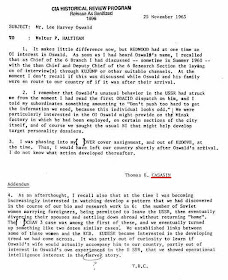"THE DUAL PLOTS"
by Greg Parker
Brief background Information on Soviet rocketry advancements obtained in the early 1950s via a joint British-US intelligence project code-named 'DRAGON RETURN' led to the CIA developing two new operations:
- One was the U2 overflight program known within CIA as 'AQUATONE'.
- The other, commencing after Stalin's death in 1953 was known as 'REDSKIN', and officially involved the use of those legally travelling to the USSR such as businessmen, sportsmen, members of the clergy, journalists and scientists.
With the advent of student exchange programs, students would be added to that list. After studying their itinerary, the CIA briefed them on targets in those areas in which information was sought. Any information was of potential importance to analysts trying to determine the current state of Russian missile technology and production, as well as what it would be 10 years hence....Potential candidates for REDSKIN were found through a network of spotters, then overtly assessed by field officers (and from the early 1960s, by psychologists posing as representatives of industry or education). They would then be "contacted by case-officers to ascertain willingness and availability for travel in the USSR on intelligence missions." Once all of those boxes were ticked, they would be sent to Washington for full Headquarters assessment and possible recruitment. Successful recruits now had the status of "agents".
--------
| Sources: | Inside the Company, Philip Agee, p. 68 | |
| Mary Ferrell's Comments: | REDSKIN = a program of using legal travellers (tourists, businessmen, scientists, journalists and practically anyone who can obtain legal entry into the Soviet Union and is willing to perform operational tasks |
~~~~~~~~~~~~~
INTERVIEW OF THOMAS CASASIN
AUGUST 17, 1978
AUGUST 17, 1978
Casasin said the Legal Travellers Program was headed at the time of his memo by Alexander Sokaloff (phonetic) of the Soviet Russia Division He said the program began pre-1960 with the lessening of tensions between the United States and the Soviet Union He said Sokaloff had come out of the Soviet Union with his parents as a child He explained that defectors such as Sokaloff were kept at arms length for security reasons by the agency.
The Legal Travellers Program operated in such a way that the agency contact was in touch with the traveller well before the proposed trip and would be informed as to which areas would be visited, what he would be doing in the country, etc. The agency contact would then be able to give the traveller the agency's "requirements for information while he was abroad. Casasin said he was not involved in the program he said he was opposed to it because it was too short term to justify the investment of resources and the risk involved.
He said he believes the travellers were told that their contacts were CIA, but he doesn't know for sure. He said cover may have been used by the contact.
~~~~~~~~~~~~~~~
A major part of Legacy of Secrecy concerns the aftermath of the assassination, the concerns of officials, and actions of cover-up. The authors maintain that some of these cover-ups were to protect Almeida and national security, but Richard Helms and others covered up for other reasons, including keeping secret the unauthorized AMLASH initiative.
A few highlights are included here:
180-10142-10036: CHRONOLOGY.
This chronology, produced by the 1970s Congressional investigation, is cited in several places. Page 58 notes FBI Director Hoover's 11-22-63 dispatch of a "cable to all field offices ordering utilization of all informants and to resolve all allegations." The next page notes that on the following day "FBI HQ cables all field offices rescinding its 11/22 order to use all informants."
104-10018-10052: VARIOUS MEMOS CONCERNING LEE HARVEY OSWALD (Chapter 20, note 11).
CIA Soviet Russia Division officer Thomas B. Casasin wrote on 11-25-63 that he had considered "laying on of interviews" with Oswald upon his return from the Soviet Union. Controversy remains on why the CIA didn't debrief Oswald, of whether indeed they did.
See Joan Mellen's Who Was Lee Harvey Oswald? for much more on the Casasin memo and this issue.
Greg Parker writes:
At this point, it would be beneficial to give a little background information on [Richard] Snyder and [Edward L.] Keenan.
- Snyder was used as a spotter for the Redskin Program at Harvard by Nelson Brickham of the Soviet Russian Division within the Directorate of Plans. Brickham was responsible for running black propaganda, false flag recruitments, and the gathering of information on Soviet missile silos.
- Keenan was a Harvard student at the time Snyder was recruiting.
Edward L. Keenan
Edward Keenan is Professor of History and Director of the Dumbarton Oaks Research Library and Collection. For many years, he was co-chair of the Program on Central Asia and the Caucasus, and in 1996-97, he co-taught Topics in the History of Central Asia: Proseminar. In addition to his major focus on mediaeval Russia, Professor Keenan has a long history of study and extensive expertise in the cultures of Central Asia, the Caucasus, Iran, etc.
Edward L. Keenan is Andrew W. Mellon Professor of History at Harvard University and Director of Harvard's Dumbarton Oaks Research Library and Collection. A specialist in medieval Muscovite history and the cultural history of the East Slavs, he has also served at Harvard as the director of the Russian Research Center, Director of the Center for Middle Eastern Studies, Dean of the Graduate School of Arts and Sciences, and chair of the History Department. His earlier works include:
- "The Kurbskii-Groznyi apocrypha: the seventeenth-century genesis of the 'correspondence' attributed to Prince A. M. Kurbskii and Tsar Ivan IV" (Cambridge: Harvard University Press, 1971), and
- a recent book of essays, "Rosiis'ki istorychni mify" (Kyiv: Krytyka, 2001).


No comments:
Post a Comment